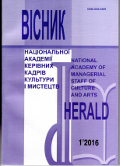МИСТЕЦТВОЗНАВСТВО ЛЬВОВА У ПЕРІОД РАДЯНСЬКОГО ТОТАЛІТАРИЗМУ
Art history in the period of soviet totalitarism
Author(s): Iryna Yaremivna MatolichSubject(s): Museology & Heritage Studies, Visual Arts, Ethics / Practical Philosophy, Cultural Anthropology / Ethnology, Higher Education
Published by: Національна академія керівних кадрів культури і мистецтв
Keywords: arts science; totalitarianism; institution; museum; thesis; conference;
Summary/Abstract: Arts is a branch of the humanities that considers art in wide public, social and cultural aspects. To understand the current state of arts science, we need to call to its history, namely the development of this science in one of the largest centers of our country – the city of Lviv, and name the first scientists in the field. Resolving this issue will provide the understanding of the integrity of Ukrainian art. In Soviet times, arts science focused mainly in Moscow and Leningrad (now – St. Petersburg) – namely, the Moscow Lomonosov State University and the Leningrad Repin Institute of Painting, Sculpture and Architecture. All scientific councils on arts thesis defense concentrated mainly in these cities. One of the important centers of arts science is Ukrainian City of Lviv. Thus, its first researchers in 1970 were candidates of Art: Antin Budzan, Pavlo Zholtovsky, Yakym Zapasko, Yuriy Lashchuk, Volodymyr Ovsiychuk, Vira Sventsitska. The main centers, where the first art museums of the city are concentrated – the Lviv Museum of Ukrainian Art, the Lviv Art Gallery, the Museum of Ethnography and Crafts, the Lviv History Museum; and educational institutions of the city – the Lviv State Institute of Crafts and Decorative Arts and the Ukrainian Ivan Fedorov Polygraphic Institute. Thus, several researchers of Ukrainian art have worked in the Lviv Museum of Ukrainian Art (now – the Andrew Sheptytsky National Museum). The most famous of them – Vira Sventsitska (most significant work – "Heritage of ages. Ukrainian painting of XIV – XVII centuries"), Irina Gurgula ("Folk Art of Western Ukraine"), Sofia Czechowicz ("Folk masters" (co-author).) Jaroslav Nanovskiy ("Ivan Trush", "Julian Pankevych"), Mykola Batih, Vitaliy Ostrovskiy ("Ivan Trush", "Anton Monastyrskiy", "Anlocal art re-searchers concentrated was the Lviv Art Gallery. The eminent Ukrainian art researchers worked here – Borys Voznytsky (author of works "Olesky castle", "Boim Chapel in Lviv"), Olena Ripko ("Searching for executed past: a retrospective of artistic culture of the city of the twentieth century"), Gregory Ostrovskyy ("Artists of the Soviet Transcarpathian region", "Lviv", "Lviv Art museums", "Zachariy Zograf", "Roman Selskiy"), Anatoliy Popov ("Elena Kulchytskaya: Graphics, Art"). The Museum of Ethnography and Crafts is one of the most important centers of Lviv arts science. Well-educated art re-searcher Pavlo Zholtovsky worked here ("Ukrainian painting of XVII – XVIII centuries", "Dictionary Encyclopedia of artists who worked in Ukraine in XVI – XVIII centuries", "Artistic life in Ukraine in XVI – XVIII centuries"), Yuriy Lashchuk ("Kosiv ceramics", "Ukrainian potters", "Development of Ukrainian national art crafts"), Faina Petriakova ("Modern Ukrainian art glass", "Ukrainian art porcelain (end of XVI – beg. of XX century.)"), Mykola Mozdyr ("Ukrainian folk memorial sculpture", "Ukrainian folk wooden sculpture", "Lupiychuk – spirit of Ukrainian Cossacks"), Ivan Seniv ("Works of Olena Kulchytska", "Essays on the history of Ukrainian arts and crafts"). Antin Budzan worked on Ukrainian decorative carving and Vladimir Rozhankivskiy worked on Crafts Blown Glass in the Lviv Museum of Ukrainian Art, and later – in the Museum of Ethnography and Crafts.The fourth center of Lviv arts science was the Lviv Historical Museum, where its director is Gregory Yakushchenko worked. The outstanding Ukrainian art critic Yakim Zapasko, who was the expert on the history of old books and publishing in Ukraine worked in the Lviv State Institute of Crafts and Decorative Art (now – the Lviv National Academy of Arts). The Ukrainian researcher of graphics and typography Hrystyna Sanotska worked in the Ukrainian Ivan Fe-dorov polygraphic institute (now – the Ukrainian Academy of Printing). Indisputable is the fact that all Ukrainian scientists had desire to participate in conferences that were held in Moscow and Leningrad. As an example, we have a conference with the Institute of Ethnology Archives in Lviv. In Lviv, they were mostly local and usually have been devoted to the life and work of individual artists, as well as to the anniversary of the museum, scientific or educational institutions. As an example, we can name conferences on works of Olena Kulchytska, Ivan Trush, Vasyl Kasian, Mykola Martinovich, Leo-pold Levitskiy, Oleksa Nowakowski. Thus, the Ukrainian arts science during Soviet totalitarianism was marked with infe-riority in comparison to Russian. At this time the main development centers of Art in Lviv were museums and universities. This period is the emergence of new researchers in the national arts science, who in 1970 already had a scientific de-gree of "candidate of art" and worked mostly in museums and universities. Researchers have written and published a number of powerful works on the history of Ukrainian art, although, considering the time, not without signs of Soviet bias. In their works, scientists and artists turned to Ukrainian folk culture. They saw a strong foundation and guarantee of national identity in it. At this time, a new scientific field that studied Ukrainian art appeared, as well as the main stages of its devel-opment, character and relationships with other cultures, thus ensuring the growth of Ukrainian national consciousness.
Journal: Вісник Національної академії керівних кадрів культури і мистецтв
- Issue Year: 2016
- Issue No: 1
- Page Range: 120-125
- Page Count: 6
- Language: Ukrainian

